Amonkhet Down to Business, Part 2
Welcome to the second Amonkhet Preview Week. Last week I introduced my design team and started talking about how Amonkhet was designed. This week I'm going to continue that story, so you might want to take a peek at last week's column if you haven't yet, as I'm going to assume you've read it. Once again, I'll have a cool preview card for you before I'm done. That's said, on with the story.
Amonkhet to Work
When last we left, we were going over the many topics we had written down for "top-down Egypt." We started with Gods and were in the middle of mummies when Part 1 ended. As I explained last week, we decided to focus the mummies in Amonkhet in white and black, with white being the dutiful servant mummies within the barrier of the city and black being the wild dangerous mummies outside of the barrier. The idea being that in the world of Amonkhet, when you die, you come back as a Zombie, but with special preparation, it needn't be too gruesome.
That preparation takes us to our first mechanic: embalm. I believe mummies are such an iconic Egyptian thing because it highlights a very specific death ritual used by the ancient Egyptians. Having creatures that are mummies highlights this process, but we wanted to take it a step further. Shortly after I handed over the reins of the design to Ethan, he presented the team with a challenge. He wanted to make a mechanic that represented embalming. Besides adding flavor to the set, it would also be another way to get more mummies for Zombie tribal.
The challenge seemed pretty easy at first. Clearly embalming would mean taking a dead creature and turning it into a mummy. The problem was you needed a clear way to distinguish between the living version of the creature and the mummy version. Normally when we do a state change, we put a counter of some kind on the card to remind the players. For instance, the monstrosity mechanic from Theros put some number of +1/+1 counters on the creature when activated.
We'd decided to capture the cruelty of the world by using -1/-1 counters as our base counters for the block, meaning +1/+1 counters were off the table. This led us to explore embalm bringing back creatures with a -1/-1 counter. Obviously, this led to us exploring persist, which we decided wasn't what we wanted. We then explored creatures with an activated ability usable only in the graveyard that could return them to the battlefield with a -1/-1 counter.
The flavor was pretty good, but we had two problems. One, we didn't want a mummy dying and then being embalmed. We wanted the mechanic to bring back creatures once, not infinitely. We tried a bunch of different tricks. If the creature had a -1/1 counter on it when it died, it was exiled. The -1/-1 counter stayed with the creature when it died so it would technically be marked in the graveyard. We had text that prevented you from embalming something if a card with that name had already been embalmed this game. All the solutions were clunky. They added lots of text, they were counter-intuitive and/or had memory issues.
Two, for a couple reasons, the mechanic required a marker. First, flavor dictated that an embalmed creature become a white Zombie. One of the reasons we wanted embalm was to get more Zombies onto the battlefield to make Zombie tribal relevant. That meant that we needed some way for players to easily tell whether something was a Zombie. Second, if we wanted you to be unable to embalm a creature a second time, we needed a way to know if a creature had previously been embalmed.
A -1/-1 counter as a marker was problematic, as we had many ways of putting a -1/-1 counter onto a creature. At the time, wither was a mechanic in the set, plus -1/-1 counters heavily encourage designs that put them on creatures (their ability to weaken creatures is one of the biggest difference from +1/+1 counters). Many creatures were going to have -1/-1 counters on them, not just embalmed creatures. That meant that it was mostly useless as a marker.
Finally one day, Shawn Main came up with an elegant solution. What if when you embalmed a creature, you didn't bring the card itself back? What if instead you exiled the card and created a token copy of it. This cleverly solved a bunch of problems. First, a token doesn't stay in the graveyard. It touches it for purposes of death triggers and then vanishes. Even though the copy would technically have embalm on it, it wouldn't be usable. Second, tokens can have token cards, and those can be used to represent a different state. If it wasn't white to begin with, it could turn white and it could have the Zombie creature type added to the type line.
Ethan loved the concept of token copies and went and talked to the art team. If we limited how many we made, would it be possible to have a unique token made for each creature with embalm? The art team said yes. That means that for every embalm creature, there is a creature token made specifically to show that creature being embalmed. To play up this gimmick, the art team designed the creatures visually to each have a distinctive silhouette.
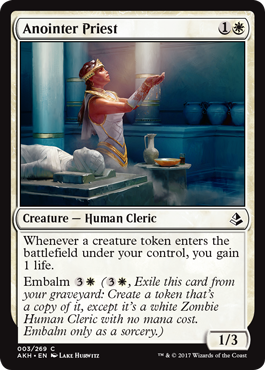
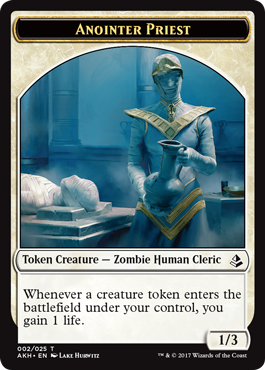
The design team ended up focusing the mechanic in white and blue. The reason was to support Zombie tribal in constructed. Shadows over Innistrad block has Zombies in blue and black. Amonkhet has Zombies (mummies) in white and black. Black Zombies in Amonkhet block are flavored as not entombed zombies, so the mechanic was a mismatch for black. By putting it in white and blue, it allowed us to maximize the number of Zombies in the three colors players will be building Zombie decks with. There is one red creature and one green creature with embalm.
Monuments
Whenever we're doing a top-down set, there are a number of different things I do to gather information about the source material we're using. One thing I do is play a word association game with anyone who'll play with me, usually people who don't have any idea why I might be asking. This helps me get a sense of what things first come to people's mind on the topic at hand. For Amonkhet, I would list different nationalities and see what was the first thing they thought of. To hide my intentions, I would go through a list of different nationalities.
Me: French
Them: Eiffel Tower
Me: Mexican
Them: Sombrero
Me: Italian
Them: Pizza
Me: Japanese
Them: Sushi
What was the number-one answer for "Egyptian"? Pyramid. And by a pretty wide margin. When many people think of Egyptian things, they think of the pyramids and the Sphinx and monuments in general. That meant we had to find a way to include monuments in the set.
We ended up discovering two ways to do this. First were the monuments to the gods. The Egyptians loved their gods and monuments, so it was pretty natural that the two would often overlap. As I explained last week, we chose to do a cycle of Gods, one in each color. The goal of these five monuments was to make a tightly knit cycle of artifacts that were tied to each God and to each color, but were still playable in any deck. In the end, we solved this problem by making two abilities—one a static ability that every monument had but directed at its own color and one a triggered ability that was usable by any color. The trigger condition was shared by all the monuments, but the effect was tied to the flavor of the God (and to their Trial, which I'll discuss next week).
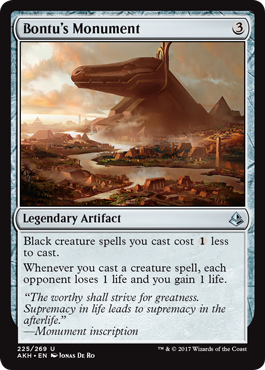
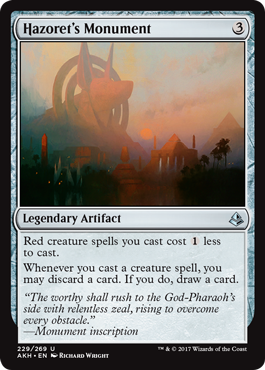
The other cycle was a vertical cycle (one common, one uncommon, and one rare/mythic rare), what we playfully called "Build-a-Monument" in design. The idea for this cycle is that each monument had two activations: one that has an effect and puts a brick counter on the artifact, and a second with a stronger version of the effect but only usable if you had three or more brick counters. This cycle was representing the constant monument-building that went on in ancient Egypt.
Deserts
A very common question when we first announced we were doing an Egyptian-theme set was, are we bringing back the card Desert?
Desert appeared in Magic's first expansion, Arabian Nights. The card saw some play in tournaments, but was greatly hampered by the fact that so many of the early decks were completely (or almost completely) creatureless. We actually had Desert in early design files but it proved to be a little too powerful to bring back.
Desert also has the distinction of being one of the first lands to have a nonbasic land subtype on it. While we couldn't bring back Desert, the card, we definitely could bring back Desert, the subtype. The theme shows up lightly in Amonkhet, but will evolve quite a bit with Hour of Devastation.
Last week I talked about how some items were listed for both top-down Egypt and top-down Bolas. Desert was one of these items, as it was both very Egyptian and very harsh and punishing (aka very Bolas).
Obsession with Death
Before design on Theros began, I assigned Ethan a research project to study Greek mythology and see where there was good overlap with Magic, both in things we'd already done and in areas we hadn't yet touched. That exercise was so successful that when we started Amonkhet, I had Shawn Main do the same thing but for Egyptian mythology. As I mentioned last week, Shawn spent several years growing up living in Egypt, so he was the obvious choice for the project (and it was something he was excited to do).
There were a lot of interesting takeaways from Shawn's write-up, but one that stuck with me was the obsession the ancient Egyptians had with death. So much of their mythology was about how people died and what was done to them when they died and what occurred to them after they died. Many of the Egyptian gods' roles dealt with different aspects of death. From reading the report, I was pretty sure we'd have at least one mechanic, if not more, that dealt with death in some way. (For those curious, we did explore using morbid, but it didn't quite fit with some of the themes I'm going to talk about below.)
Meanwhile, when we shifted to the two-block model, we hypothesized that it would be good to have the first and third blocks in Standard (remember at the time, Standard was planned to be eighteen months; we've since reverted back to 24 months) overlap in some theme. What theme from Amonkhet block could overlap with Shadows over Innistrad block? The obsession with death tied nicely into the graveyard theme that played a big role in Shadows over Innistrad.
To separate Amonkhet from Shadows over Innistrad, we decided to have them care about the graveyard differently. Shadows over Innstrad uses what we call a "graveyard as barometer" theme where the different cards and mechanics look at what's in the graveyard to help strengthen them. Delirium is a good example. By getting four or more different card types in the graveyard, you make your cards better.
Amonkhet could instead use a "graveyard as resource" theme where you exile cards in the graveyard as a means to get extra value out of them. This theme makes you want to fill up your graveyard not because you're looking at what cards are in your graveyard, but because your graveyard is a resource you can spend to get extra power. The most famous "graveyard as resource" mechanic is flashback, which allows you to cast the same spell twice. Amonkhet wouldn't get flashback specifically, but would get two mechanics that were very flashback-esque.
The first is embalm. You get a creature, and when it dies you can spend mana to use it a second time. The second mechanic is my preview for today, a mechanic we call aftermath.
Aftermath interestingly came about because we were brainstorming ways that we could help delirium. We were examining if there was any other way to put two card types on a single card like artifact creatures do when I said, "I thought of one. We could make a split card that's an instant on one side and a sorcery on the other." Due to the property of split cards, this would make it both an instant and a sorcery in the graveyard.
The talk of split cards got crossed with the talk of "graveyard as resource" and we ended up with a card where it had one effect in your hand and a different effect in your graveyard. It was flashback, but one where the two effects weren't the same. To better show you what I mean, why don't I show you my preview card for today?
Click here to see Never to Return
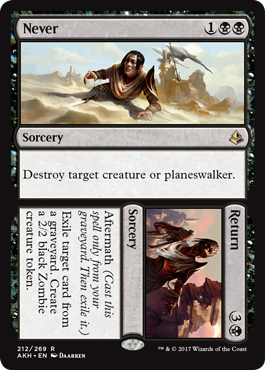
Let's start with the layout, as that's the most visually striking thing about the card. When we started, we thought we'd just make aftermath as split cards but put a restriction on the second mini-card. It soon became clear though that while aftermath might have been inspired by split cards, it was a different entity. We tried a lot of experiments and eventually settled on a card that had two different orientations. The spell you can cast out of your hand is vertical like a normal card, and the spell you can cast out of your graveyard is sideways. The idea is that you can turn aftermath cards sideways in your graveyard so you can see what spells you have access to.
Split card use a naming structure where the two mini-card names form a "Blank and Blank" expression (e.g. Assault and Battery). For aftermath, we decided to try something different. Since you always use one spell and then the other, the naming convention we settled on was "Blank to Blank" expressions.
The cards were also designed such that if you had enough mana that you could cast both, the two effects had some synergy with one another. For instance, if you have 3BBB, you can both kill a pesky creature and then exile it from the graveyard to get a 2/2 Zombie token. This might be good if the creature has an ability that works in the graveyard like embalm.
Tomb Raiding
Another thing we found as we studied pop cultures was that there are two different ways Egyptian themes got used. Either it's in sunny, living Egypt or it's in dark, dead Egypt. The former is seen in things like The Ten Commandments, Stargate, and the recent Gods of Egypt. The latter is seen in things like Tomb Raider and The Mummy. We decided early on that we were going to be doing the former and not the latter. Amonkhet wasn't going to be seen as a dusty, dead civilization that our heroes were discovering long after its death. This cut off a few tropes, but we looked for places to put the kinds of things you'd find in an Egyptian archeological dig, like say a sarcophagus as a new item rather than a dusty old one.
Hieroglyphics
This was a theme that I was eager to weave into the set. I didn't expect us to use actual Egyptian hieroglyphics, but I assumed we could make our own version. I even created a mechanic to support it.
Blue God Sends You Away
1U
Instant
Return target creature to its owner's hand.
Hieroglyphics (You may pay 2 and exile this card to draw a card.)
The flavor of hieroglyphics was pretty cool. If you dug them up out of the grave, you could learn things from them. The set needed a mana-smoothing mechanic, so I was pretty sure I'd hit pay dirt. Unfortunately, at about the same time in development, investigate was created for Shadows over Innistrad. The two mechanics aren't exactly the same, but they're similar enough that it didn't make sense to have them both in Standard at the same time. I did hunt for another hieroglyphics mechanic, but as I'll explain next week, another mana-smoothing mechanic ended up taking that slot.
Curses
Most of the items we stuck up on the white board didn't already have a Magic mechanic attached to them. Curses, though, were the exception. We introduced Curses in Innistrad as part of the horror world, but Egyptian mythology definitely had curses play a role in it. In the end, we decided to include them but just make a few. (Editor's note: An earlier version of this article erroneously attributed Curses to Zendikar.)

Amonkhet Going
And with that we get to the end of the top-down Egypt list. (There were a lot of other smaller things that led to individual card designs, but these were the ones that led to mechanics and larger themes.) I hope you're enjoying the design story so far. As always, you can email me or contact me through any of my social media accounts (Twitter, Tumblr, Google+, and Instagram) to tell me what you think of this column or of Amonket.
Join me next week when I get to the top-down Bolas list.
Until then, may you enjoy the Egyptian influences of Amonkhet.
#424: 20 Lessons: Don't Prove
#424: 20 Lessons: Don't Prove
48:29
This is another podcast in my "20 Lessons, 20 Podcasts" series with design lessons from my GDC talk. Today's podcast talks about Lesson #12: Don't Design Something to Prove You Can.
#425: Lessons Learned: Battle for Zendikar
#425: Lessons Learned: Battle for Zendikar
39:29
This podcast is another in my "Lessons Learned" series where I talk about sets I led the design for and the lessons I learned from leading it. In this podcast, I discuss what I learned from leading the design for Battle for Zendikar.
- Episode 423 Virtual Tour (24.4 MB)
- Episode 422 Behind the Scenes (24.9 MB)
- Episode 421 Strengths and Weaknesses (24.1 MB)

